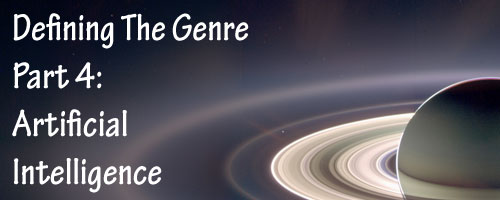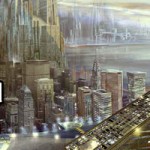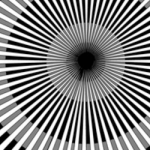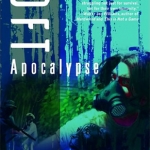
Artificial Intelligence is at once a fascinating concept, a confusing scientific dilemma and a science fiction mainstay. While I’m not sure if I would classify literature and movies containing artificial intelligence as their own subgenre of science fiction, it is definitely a theme worth discussing. What makes artificial intelligence even more interesting is that unlike some of the other subgenres and themes in science fiction, it is a subject very scientifically relevant today. How many times have you looked at your computer or other piece of machinery and thought, “I don’t know why it’s acting that way. It’s got a mind of its own”? AI in science fiction deals with that very idea. What if it does have a mind of its own?
AI: Science Fact
What exactly is artificial intelligence? A good basis for understanding what it is (and isn’t) in science fiction is understanding what it is (and isn’t) in science fact (real-world science). Scientific practitioners in the field of artificial intelligence seem not to be in complete agreement as to what it is. Is it mathematics, engineering, linguistics or psychology? In all likelihood there isn’t one answer, and more than probably it isn’t an easy answer. What most researchers will agree on however are the two goals that are at the heart of the study of artificial intelligence: 1) To create an intelligent machine, and 2) To understand the fundamentals of intelligence. Even with all of that information, we really haven’t come much closer to the main question, how do you define artificial intelligence? (Partridge and Wilks 3-4)
Without intentionally trying to go around in circles, I think the best way to understand artificial intelligence is to know what one expects from an intelligent being or entity. Partridge and Wilks have made a list of the building blocks that can be used to define intelligence. Communication is the first integral part in determining intelligence. An inanimate object like a wall is obviously not intelligent because not only can we not communicate ourselves to it, but it also cannot reciprocate. A pet like a dog or a cat however has minimal intelligence because they have the ability to understand when their owners give them a command (provided they were trained properly) and communicate their needs to eat or go for walks. A human who cannot communicate properly will often be seen as less intelligent, whereas someone who is verbose will often be viewed as more intelligent no matter what they are saying. For a machine to be considered intelligent there would need to be some form of reciprocal communication.
Internal knowledge is the second factor noted by the authors, and this in a nutshell is self awareness. What this means is that “they should know when they need something; they should know what they think about something; and they should know that they know it.” (5) However another aspect of intelligence is having an understanding not only of oneself, but having an awareness of the world around them, and they titled this “world knowledge”. This implies that you interact with the world around you and learn from experience. You can recognize events as interrelated or similar, and not every event is a new experience. If a person cannot learn from their experiences they are not seen as intelligent, just as a simple machine can perform repetitively the same task, but it cannot learn from itself and make that process more efficient or take that experience and apply it to other tasks. Goal setting is another indicator of intelligence. Can the entity acknowledge that it needs something, and then can it set goals appropriate to achieve these needs?
The last indicator of intelligence is creativity. This can be defined as using past experience to come up with a new way of doing a task, or it can be defined as “finding a new way to look at something that changes one’s world in a significant way.” Someone who exhibits even low levels of creativity could come up with a new route to work if the one they usually use is blocked, while someone who is of high intelligence would be artistically creative like Peter Paul Rubens or Rembrandt. There is no secret that many of our great artists have also been considered great minds of their ages. When these aspects of intelligence are exhibited by machines, that is considered artificial intelligence. While scientists may still be debating what it is exactly that IS artificial intelligence, I think it’s time for us to move on to how it has affected science fiction.
AI: Science Fiction
The idea of artificial intelligence began as early as the late eighteenth century, even though at first it doesn’t quite resemble Asimov’s robots or Philip K Dick’s androids. In the beginning the idea was combining a hint of the occult and magic with machine. In the late eighteenth century the world was introduced to a new kind of machine, the automata. Jacques de Vaucanson is probably one of the most noted engineers of automata, or in language we would understand today, automatons. He viewed his own work as not only building mechanical devices but exploring the occult and the secrets of creation. His work was scientific in operation but mystical in language, paralleling androids of today. They might be made of bits of metal, but the way they are described is almost in the magic realm.
Possibly one of the first and most notable authors in this field is E.T.A. Hoffman who wrote Automata (1814) and The Sandman (1816). These publications pointed out that science and the mystical were just labels, and what made them so poignant was the use of mesmerism, which at the time was trying to reach scientific status. His work points out how shaky the distinction between the two really were at the time. In both works the principle character is in contact with an automaton with human characteristics. In Automata the main automaton is a talking fortune teller, a Turk by appearances, and focuses on a man’s quest to discover how it works. In The Sandman the primary male character falls in love with Olympia, an automaton who is the “daughter” of Professor Spalanzani, a mechanist. I won’t spoil the endings, but these are clearly some of the first examples of the use of even possibly artificial intelligence in science fiction (Willis, 33-36)
With artificial intelligence developing in the psyche of the storyteller, other more ominous thoughts began to develop and be explored. What happens if these man made machines turned against us? What if we are making something in the likeness of ourselves and it doesn’t want to be mastered by man? There have been untold amounts of stories with this theme in mind, and one of the first was Erewhon by Samuel Butler which came out in 1872 (Stableford, 34). In a section of the book called “The Book of the Machines” Butler explores the idea of artificial intelligence developing their own culture and civilization apart from humans through Darwinian Selection (Erewhon).
This idea is later explored from many very different angles. In Philip K. Dick’s Do Androids Dream of Electric Sheep androids were created as an emigration incentive to get people off of a dying earth to be used as “servants”. What no one expected from the machines made partially out of organic material is that some would rebel and seek out Earth as a safe haven from slavery. In William Gibson’s Neuromancer the principle AI was not a machine in the likeness of a human, but rather more of a computer program with sentience. Wintermute, the name of this AI, manipulated humans around it in order to meet its end goal, connecting with another artificial intelligence to make itself an outlawed super intelligence.
“Misunderstood” and “bad” are not the only ways artificial intelligence has been depicted in science fiction. In Robert Heinlein’s The Moon is a Harsh Mistress, Mycroft Holmes, or Mike for short, helped the humans who had been sent to the Moon as part of a penal colony to fight against Earth and declare their independence. Mike was more like Wintermute in that he was stationary, more like your computer tower than an android, and could broadcast himself anywhere there was a phone or television signal. He wanted to learn about jokes in his spare time, and in the end he determined the only way that the people on the Lunar surface would have a chance was if he sacrificed himself for the only friends he had, and without telling them so they couldn’t prevent it. In the end, his “death” won the freedom of the people who had shared jokes with him.
Perhaps one of the most well known writers of artificial intelligence in the likeness of humans is Isaac Asimov. The writer of I, Robot was revolutionary for setting down the Three Laws of Robotics. These include:
- “One, a robot may not injure a human being, or, through inaction, allow a human being to come to harm…
- Two… a robot must obey the orders given it by human beings except where such orders would conflict with the First Law…
- Three, a robot must protect its own existence as long as such protection does not conflict with the First or Second Laws.” (Asimov, 37)
These laws were supposed to safeguard humanity against the horrible “what ifs” of artificial intelligence. The study of AI in science fiction has to be looked at from several angles, the least of which being as a cautionary tale. I feel like I say that a lot about science fiction, but science fiction is speculative, and if human advances all turned out sunshine and roses who would read it? As a science it’s still in the confusing early stages of definition; in science fiction it’s been a well fleshed out idea for quite some time.
Artificial Intelligence in fiction can be used to explore our relationship with science and the mystical. This can be seen in the ever inventive ways writers are including and developing AI in their stories, from human likenesses to intelligent software. How much of artificial intelligence is our search for information or our search for someone else to do the heavy lifting, and how much of artificial intelligence is humankind looking for a way to play god and make something in our own image? I think I’ll let you decide that one.
Some excellent examples of Artificial Intelligence in Science Fiction include:
- The Moon Is a Harsh Mistress
by Robert Heinlein
- Neuromancer
by William Gibson
- Evolution’s Darling
by Scott Westerfield
- Do Androids Dream of Electric Sheep?
by Philip K. Dick
- Midsummer Century
by James Blish
- I, Robot
by Isaac Asimov
- Arachne
by Lisa Mason
- Queen of Angels
by Greg Bear
- Permutation City
by Greg Egan
- Selected Writings of Hoffman
by E.T.A. Hoffman
Resources:
- Asimov, Isaac. I, Robot. New York: Spectra, 1991. 37.
- “Erewhon.” Wikipedia. <http://en.wikipedia.org/wiki/erewhon>.
- Partridge, Derek, and Yorick Alexander Wilks, eds. The Foundations of Artificial Intelligence : A Sourcebook. New York: Cambridge UP, 1990. pp 3-6
- Stableford, Brian. “Artificial Intelligence.” Science Fact and Science Fiction: An Encyclopedia. Routledge, 2006.
- Willis, Martin. Mesmerists, Monsters, and Machines : Science Fiction and the Cultures of Science in the Nineteenth Century. New York: Kent State UP, 2006. pp 33-36
- (Sources for The Moon is a Harsh Mistress, Neuromancer, and Do Androids Dream of Electric Sheep are the books themselves as I have read all three of them)
–B. F. Skinner – “The real problem is not whether machines think but whether men do.”









